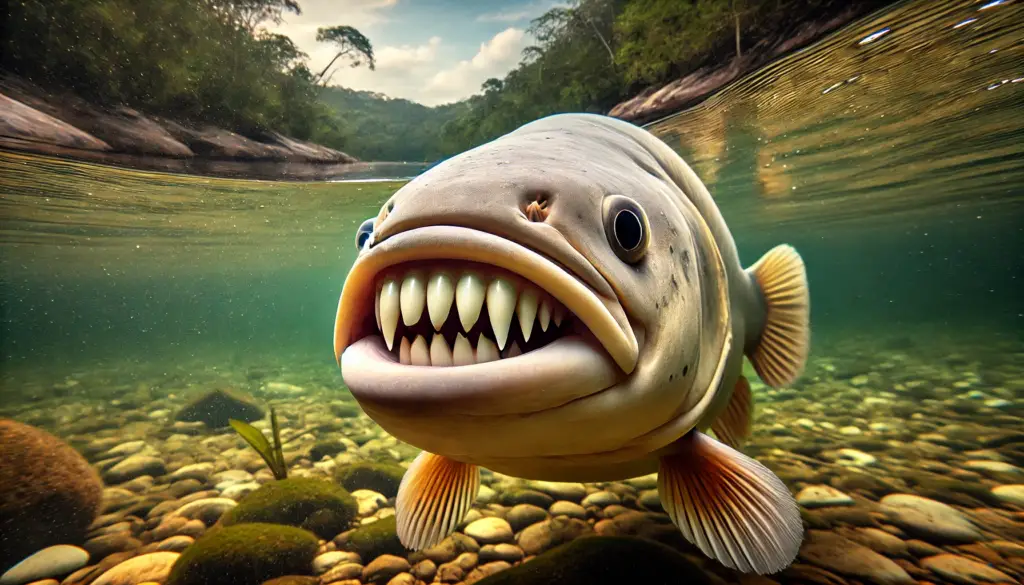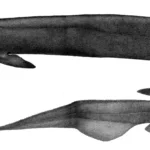The Pacu fish is one of the most fascinating and unusual freshwater species, primarily known for its distinctive human-like teeth. Native to South American rivers, particularly in the Amazon and Orinoco basins, the Pacu has gained attention due to its odd dental appearance, which resembles human molars. While its close relative, the piranha, is known for its sharp teeth and carnivorous habits, the Pacu is largely a peaceful herbivore with a unique and surprising set of teeth adapted for crushing plant material.
In this article, we’ll dive into the world of the Pacu fish, exploring its habitat, diet, characteristics, and why it has developed such strikingly human-like teeth.
What Is a Pacu Fish?
The Pacu fish is a freshwater species belonging to the Characidae family, the same family as piranhas. However, despite their shared lineage, the Pacu and piranha are quite different in terms of behavior and diet. The most distinguishing feature of the Pacu is its teeth, which are flat and broad, resembling human molars, rather than the sharp, pointed teeth of the piranha.
Pacu fish are often found in the Amazon and Orinoco river basins, but they have also been introduced to various other regions, including parts of the United States and Southeast Asia, often due to aquarium releases.
Appearance
Pacu fish have a robust, flat body, typically gray, black, or silver in color, with a deep, rounded belly. They can grow quite large, with some species reaching lengths of up to 3 feet (90 cm) and weights of up to 55 pounds (25 kg). Their wide, blunt head and powerful jawline, combined with their strange teeth, give them a unique appearance that sets them apart from most other freshwater fish.
The Human-Like Teeth of the Pacu Fish
Perhaps the most fascinating feature of the Pacu fish is its teeth. While most fish have sharp, pointed teeth designed to tear flesh or grip prey, the Pacu’s teeth are flat, square, and blunt, much like human molars. These teeth are perfectly adapted for the Pacu’s diet, which primarily consists of nuts, seeds, and plant material.
Why Do Pacu Fish Have Human-Like Teeth?
The Pacu’s teeth have evolved to suit its omnivorous diet. In the wild, the Pacu feeds on a variety of plant-based foods, including fruits, nuts, seeds, and aquatic vegetation. Its teeth are designed to crush and grind tough plant materials and seeds, enabling it to access nutrients that are difficult for many other fish to process.
Unlike their piranha cousins, which use razor-sharp teeth to shred meat, the Pacu’s molar-like teeth help them break down hard shells and fibers. The strong jaws and human-like teeth allow Pacu fish to chew through tough plant materials, which are common in their natural environment.
Anatomy of Pacu Teeth
- Flat and Broad Molars: The teeth in the front of the Pacu’s mouth are particularly striking because they look eerily similar to human front teeth. These are followed by rows of broad molars toward the back, which help the fish grind up harder plant matter.
- Large and Powerful Jaw: Pacu fish have strong jaws that give them the power to crush through hard seeds, which would be difficult for most other species to consume.
The combination of flat, molar-like teeth and powerful jaw strength makes the Pacu uniquely adapted for a diet rich in plant material, especially nuts and seeds, which occasionally fall into rivers from overhanging trees.
Diet: What Do Pacu Fish Eat?
The Pacu fish is primarily herbivorous, though it is technically an omnivore and can adapt its diet depending on the availability of food. Its primary diet consists of fruits, nuts, seeds, and algae. In some regions, Pacu fish are known to feed on floating plant material or even small invertebrates.
Natural Diet in the Wild
In the Amazon, where the Pacu is native, its diet often includes:
- Fruits and Nuts: During the wet season, the Amazon floods, and many trees drop fruits and nuts into the water. Pacu fish feast on these fallen fruits, using their molar-like teeth to crush them open.
- Aquatic Vegetation: The Pacu also consumes aquatic plants and algae, which provide essential nutrients.
- Insects and Small Fish: While primarily herbivorous, the Pacu will occasionally eat insects, small fish, or crustaceans if plant material is scarce.
Pacu Diet in Captivity
In aquariums or fish farms, Pacu fish are often fed a balanced diet of vegetables, nuts, grains, and sometimes pellets designed for herbivorous fish. Owners need to provide a varied diet to mimic the natural conditions of the fish’s wild habitat.
Pacu fish in captivity have a reputation for being opportunistic feeders, and in some cases, they have been known to nibble on unconventional items, including small animals or even human flesh, leading to exaggerated reports about their aggression.
Habitat and Distribution
Native Habitat
The Pacu fish is native to the freshwater rivers and floodplains of South America, primarily in the Amazon River basin, the Orinoco River basin, and the Paraná River in Paraguay. These regions are known for their tropical climate and diverse ecosystems, with rivers rich in plant life that supports the Pacu’s omnivorous diet.
In the Amazon, Pacu fish thrive in flooded forests during the rainy season, where they feed on nuts and fruits that fall into the water. They also inhabit slow-moving streams, lakes, and ponds.
Introduced Populations
Unfortunately, Pacu fish have been introduced to various ecosystems outside of South America, often by aquarium owners who released them into local rivers. Today, they can be found in parts of the United States, including Florida, Texas, and even as far north as New Jersey. They have also been introduced in Southeast Asia and India.
The introduction of Pacu fish to non-native environments has raised concerns, as they can become invasive species, competing with local wildlife for food and resources.
Pacu vs. Piranha: What’s the Difference?
While Pacu and piranhas are often compared due to their similar appearance, the two fish are quite different in terms of behavior, diet, and even anatomy.
1. Teeth
- Pacu: As mentioned earlier, the Pacu has flat, human-like teeth designed for crushing plant material.
- Piranha: Piranhas have sharp, pointed teeth that are adapted for tearing flesh. Piranhas are carnivorous and use their teeth to bite and tear through prey.
2. Diet
- Pacu: Pacu are primarily herbivorous but will eat small animals or invertebrates if necessary. Their diet mainly consists of fruits, nuts, seeds, and plants.
- Piranha: Piranhas are carnivorous, feeding on fish, insects, and occasionally small mammals or birds. They are known for their feeding frenzies, where they rapidly tear apart prey.
3. Behavior
- Pacu: Pacu are generally peaceful fish that pose little threat to humans. They are slow-moving and non-aggressive, making them suitable for large aquariums.
- Piranha: Piranhas have a reputation for being aggressive, especially in large groups, although they rarely pose a threat to humans unless provoked or starving.
Reproduction and Lifespan
Pacu fish reach sexual maturity around 2 to 3 years of age, and their breeding patterns are similar to other river fish. They typically spawn during the rainy season when water levels rise, and the flooded forest provides plenty of food for the developing fry.
In the wild, Pacu can live for up to 20 years. In captivity, with proper care and a well-balanced diet, they can live even longer, sometimes up to 25 years.
Concerns with Invasive Pacu Populations
The introduction of Pacu fish to non-native environments has raised ecological concerns. As an invasive species, Pacu can disrupt local ecosystems by competing with native fish for food and resources. In some areas, their presence has had a negative impact on native fish populations, particularly in the United States and parts of Asia.
In addition to outcompeting local species, Pacu fish have also been associated with urban legends and myths due to their teeth. Some false reports have claimed that Pacu fish have bitten swimmers or anglers, though these incidents are rare and often exaggerated.
Fascinating Facts About Pacu Fish
- Human-Like Teeth: The Pacu’s teeth are one of the most unusual features in the fish world, closely resembling human molars, which are perfect for grinding nuts and plant material.
- Size: Pacu fish can grow quite large, sometimes reaching lengths of up to 3 feet and weighing up to 55 pounds.
- Long Lifespan: Pacu fish can live up to 20 years in the wild and even longer in captivity, making them a long-term commitment for aquarium enthusiasts.
- Herbivorous Diet: Unlike their carnivorous relatives, piranhas, Pacu are primarily herbivores, feeding on fruits, nuts, seeds, and vegetation.
- Invasive Species: The Pacu has been introduced to ecosystems outside of South America, where it can become an invasive species, disrupting local wildlife.
Conclusion
The Pacu fish is a truly fascinating species, known for its unique human-like teeth and peaceful, herbivorous lifestyle. Unlike its piranha cousins, the Pacu’s teeth are designed for crushing nuts, seeds, and plant material, allowing it to thrive in the lush, tropical rivers of South America. While they are a popular choice for aquarium enthusiasts, they are also considered an invasive species in certain regions, making them a fish that must be handled with care and responsibility.
Whether admired for its appearance or studied for its ecological impact, the Pacu is undoubtedly one of the most interesting fish in the freshwater world.
FAQs
Why do Pacu fish have human-like teeth?
Pacu fish have flat, molar-like teeth designed to crush and grind plant material such as nuts, seeds, and vegetation. These teeth allow the fish to process tough, fibrous foods.
Are Pacu fish dangerous to humans?
Pacu fish are generally not dangerous to humans. They are peaceful fish, and while they have strong jaws, they are not aggressive. Rare reports of Pacu fish biting humans are often exaggerated.
How big can a Pacu fish get?
Pacu fish can grow up to 3 feet in length and weigh as much as 55 pounds, making them one of the larger freshwater species.
Where are Pacu fish found?
Pacu fish are native to the Amazon and Orinoco river basins in South America, but they have also been introduced to parts of the United States, Southeast Asia, and other regions due to aquarium releases.
What do Pacu fish eat?
Pacu fish are primarily herbivores, feeding on fruits, nuts, seeds, and aquatic vegetation. However, they are technically omnivores and may occasionally eat small invertebrates or other animals.


